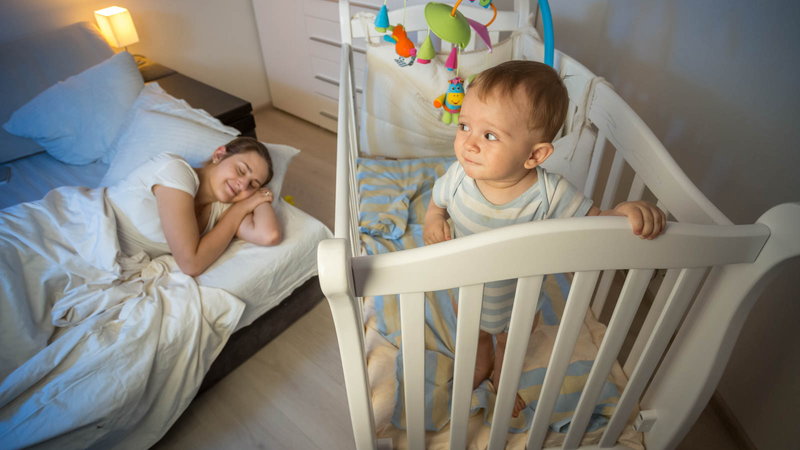
Your new baby loves to be held close, and for some reason it’s just as comforting to you. That’s why many parents get into a cozy little bedtime routine that involves rocking, nursing, offering a warm bottle, or even simply letting their little ones drift off in Mom’s or Dad’s arms. But sooner or later when it’s time to sleep in the crib, your baby won’t have any of it. And it’s no wonder: He probably sees the crib as a cold, empty place compared to the warmth of your arms. So how do you teach your baby to go to sleep – and stay asleep – in the crib?

Strategies for Comforting Baby in the Crib
For starters, you have to set the scene by helping your baby get adjusted to the idea that the crib is a comforting place to be. Give her an opportunity to play in it during the day with a few of her favorite toys (while staying with her) so she comes to see the crib as a familiar, happy place.
You can also help your baby develop attachments to something other than Mom or Dad – i.e. a “lovey” or other safe transitional object. Keep the object close to him during your regular bedtime routine so that he comes to associate it with sleep. Many babies use a soft, infant-safe stuffed animal or small blanket. Some moms wear a small cloth inside their shirt for a few hours and then let the baby cuddle and smell that cloth with Mommy’s scent on it at bedtime.
Next you need to have a soothing, predictable bedtime routine so that your baby knows that bedtime is coming. It doesn’t matter what order you do things in (bottle, bath, story, song, etc.) as long as you do it the same way every night. Predictability and routines create comfort and a sense of security for your little ones.
Now comes the hard part – getting the baby to sleep. Begin by going through the usual routine so that she is drowsy but not fully asleep. Then place her in the crib. If you’re lucky, she will get the idea that it’s time to sleep and will go down from there. But often the simple act of getting into the crib is enough to get your baby into full-scale rebellion. From here on, you can go in several different directions depending on your comfort level and the baby’s adaptability.

Strategies for After Baby Is in the Crib
Some parents stay in the room and continue to rub or pat the baby on the back until he falls asleep, applying gentle pressure on his back and helping him lie down again if he tries to get up. The advantage of going this route is that it is gentler on your baby; the disadvantage is he will continue to rely on you, at least in part, to help him get to sleep.
Another method is to back off from this kind of intervention slowly and gradually. You can begin with the patting on the back and soothing, and once your baby has done that for several days or weeks, you can start gradually backing away and reassuring her from a greater distance each night. After a few more weeks she should be used to having you say goodnight and leaving the room. This method is also somewhat gentler on your baby, but it could take weeks or months to implement.
Alternatively, you can gently put your baby down, reassure him verbally, and then leave the room altogether. You then continue to check in at regular intervals, say, five minutes, then ten minutes, and so on. Each time you come in, reassure him and let him know that it’s time for sleep: “I love you. You’re OK. Good night – it’s sleepytime.” The advantage is that he will learn to fall asleep on his own but the disadvantage is that the learning process may involve lots of tears (on the part of the baby and sometimes Mom too).
Once your baby is finally asleep in the crib the question becomes, “How do I get her to stay asleep?” You can help by making sure that your baby is dry and comfortable – not too hot and not too cold – before she goes down. The room should be dark, with black-out shades if possible. And if there is a chance of outside noise, consider using a white noise machine so the baby won’t be awakened by, say, the sound of her brothers running down the hall or a taxi beeping its horn outside.
Getting your baby to sleep in the crib can be a difficult process, and it almost certainly won’t happen overnight. Be patient, and give it some time. And as hard as this transition may seem, remember that once your little one learns to sleep in the crib, everyone in the house will have a better nights’ sleep.
